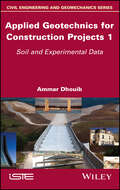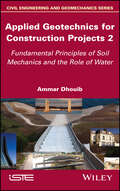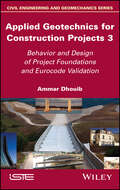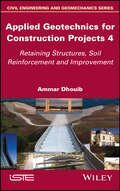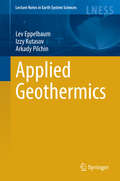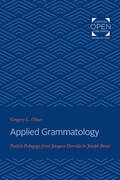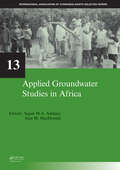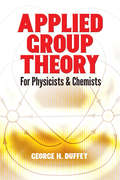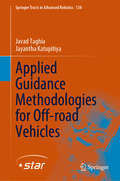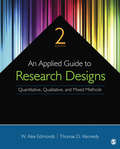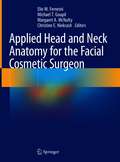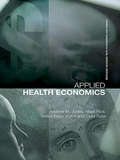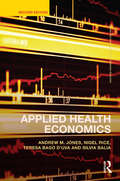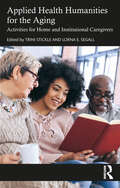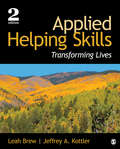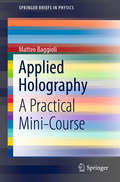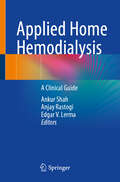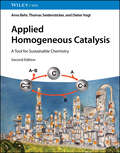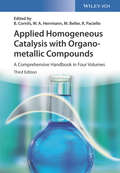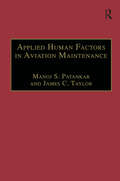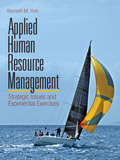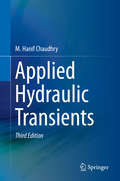- Table View
- List View
Applied Geotechnics for Construction Projects, Volume 1: Soil and Experimental Data
by Ammar DhouibApplied Geotechnics for Construction Projects, Volume 1: Soil and Experimental Data
Applied Geotechnics for Construction Projects, Volume 2: Fundamental Principles of Soil Mechanics and the Role of Water
by Ammar DhouibApplied Geotechnics for Construction Projects, Volume 2: Fundamental Principles of Soil Mechanics and the Role of Water
Applied Geotechnics for Construction Projects, Volume 3: Behavior and Design of Project Foundations and Eurocode Validation
by Ammar DhouibApplied Geotechnics for Construction Projects, Volume 3: Behavior and Design of Project Foundations and Eurocode Validation
Applied Geotechnics for Construction Projects, Volume 4: Retaining Structures, Soil Reinforcement and Improvement
by Ammar DhouibApplied Geotechnics for Construction Projects, Volume 4: Retaining Structures, Soil Reinforcement and Improvement
Applied Geothermics (Lecture Notes in Earth System Sciences)
by Lev Eppelbaum Izzy Kutasov Arkady PilchinThis book describes origin and characteristics of the Earth's thermal field, thermal flow propagation and some thermal phenomena in the Earth. Description of thermal properties of rocks and methods of thermal field measurements in boreholes, underground, at near-surface conditions enables to understand the principles of temperature field acquisition and geothermal model development. Processing and interpretation of geothermal data are shown on numerous field examples from different regions of the world. The book warps, for instance, such fields as analysis of thermal regime of the Earth's crust, evolution and thermodynamic conditions of the magma-ocean and early Earth atmosphere, thermal properties of permafrost, thermal waters, geysers and mud volcanoes, methods of Curie discontinuity construction, quantitative interpretation of thermal anomalies, examination of some nonlinear effects, and integration of geothermal data with other geophysical methods. This book is intended for students and researchers in the field of Earth Sciences and Environment studying thermal processes in the Earth and in the subsurface. It will be useful for specialists applying thermal field analysis in petroleum, water and ore geophysics, environmental and ecological studies, archaeological prospection and climate of the past.
Applied Grammatology: Post(e)-Pedagogy from Jacques Derrida to Joseph Beuys
by Gregory L. UlmerOriginally published in 1984. In Applied Grammatology, Gregory Ulmer provides an extraordinary introduction to the third, "applied" phase of grammatology, the "science of writing," outlined by Jacques Derrida in Of Grammatology. Ulmer looks to the later experimental works of Derrida (beginning with Glas and continuing through Truth in Painting and The Post Card). In these, he discovers a critical methodology radically different from the deconstruction for which Derrida is known. At the same time, he finds the source of a new pedagogy for all the humanities, one based on grammatology and appropriate to the era of audiovisual communications in which we live. Detractors of Derrida often accuse him of superficial wordplay and of using images and puns as nonfunctional subversions of academic conventions. Ulmer argues that there is, in fact, a fully developed use of homonyms in Derrida's style, which produces its own distinctive knowledge and insight. Derrida's experiments with images, moreover—his expansion of descriptions of everyday objects such as umbrellas, matchboxes, and post cards into cognitive models—serve to reveal a simplicity underlying intellectual discourse, which could be used to eliminate the gap separating the general public from specialists in cultural studies. Comparing the stylistic innovations of Derrida with Jacques Lacan's use of puns and diagrams, with the German performance artist Joseph Beuys's demonstration of models, and with the "montage writing" of the films of Sergei Eisenstein, Ulmer explores the possibility of deriving a postmodernist pedagogy from Derrida's texts. The first study to suggest the full potential of the program available in Derrida's writings, Applied Grammatology is also the first outline of a Derridean alternative to deconstructionism. With its shift away from Derrida's philosophical studies to his experimental texts, Ulmer's book aims to inaugurate a new movement in the American adaptation of contemporary French theory.
Applied Groundwater Studies in Africa: IAH Selected Papers on Hydrogeology, volume 13
by Segun Adelana Alan MacDonaldGroundwater is Africa‘s most precious natural resource, providing reliable water supplies for many people. Further development of groundwater resources is fundamental to increasing access to safe water across the continent to meet coverage targets and reduce poverty. There is also an increasing interest in the use of groundwater for irrigated
Applied Group Theory: For Physicists and Chemists (Dover Books on Physics)
by George H. DuffeyThis text introduces advanced undergraduates and graduate students to symmetry relations by means of group theory. Key relationships are derived in detail from first principles. Rather than matrix theory, the treatment employs algebraic theory in deriving the properties of characters and projection operators. This approach is customarily employed in quantum mechanics courses and makes the connection to group structure clearer. Cayley diagrams illustrate the structure of finite groups. Permutation groups are considered in some detail, and the special methods needed for continuous groups are developed.The treatment's broad range of applications offers students assistance in analyzing the modes of motion of symmetric classical systems; the constitutive relations in crystalline systems; the modes of vibration in molecules; the molecular orbitals of molecules; the electronic structures of atoms; the attendant spectra; and fundamental particle multiplets. Each chapter concludes with a concise review, discussion questions, problems, and references. 1992 edition.
Applied Guidance Methodologies for Off-road Vehicles (Springer Tracts in Advanced Robotics #138)
by Javad Taghia Jayantha KatupitiyaThis book provides methodologies for designing and implementing guidance algorithms for autonomous vehicles. These algorithms make important decision regarding how to steer and drive a ground vehicle in order to safely stay on an intended path, thereby making the vehicle driverless. The design tools provided in this book enable the reader to develop highly practical and real-world implementable guidance algorithms that will deliver high-accuracy driving for field vehicles. (They are equally applicable for on-road vehicles.) The book covers a variety of vehicle types, including wheeled vehicles, tracked vehicles, wheeled and tracked vehicles towing trailers, and four-wheel-steer and four-wheel-drive vehicles. It also covers active trailers that are driven and steered. Vehicles used in agriculture, mining and road construction are subjected to unpredictable and significant disturbances. The robust control methodologies presented can successfully compensate for these disturbances, as confirmed by the experimental results presented. Though the majority of the methodologies presented are based on sliding-mode controllers, other robust control methodologies are also discussed. To help the reader decide which controller is best suited for his/her choice of vehicle, experimental results are presented in a comparative format.
An Applied Guide to Research Designs: Quantitative, Qualitative, and Mixed Methods
by W. Alex Edmonds Thomas D. KennedyThe Second Edition of An Applied Guide to Research Designs offers researchers in the social and behavioral sciences guidance for selecting the most appropriate research design to apply in their study. Using consistent terminology, the authors visually present a range of research designs used in quantitative, qualitative, and mixed methods to help readers conceptualize, construct, test, and problem solve in their investigation. The Second Edition features revamped and expanded coverage of research designs, new real-world examples and references, a new chapter on action research, and updated ancillaries.
An Applied Guide to Research Designs: Quantitative, Qualitative, and Mixed Methods
by W. Alex Edmonds Thomas D. KennedyThe Second Edition of An Applied Guide to Research Designs offers researchers in the social and behavioral sciences guidance for selecting the most appropriate research design to apply in their study. Using consistent terminology, the authors visually present a range of research designs used in quantitative, qualitative, and mixed methods to help readers conceptualize, construct, test, and problem solve in their investigation. The Second Edition features revamped and expanded coverage of research designs, new real-world examples and references, a new chapter on action research, and updated ancillaries.
Applied Head and Neck Anatomy for the Facial Cosmetic Surgeon
by Elie M. Ferneini Michael T. Goupil Margaret A. McNulty Christine E. NiekrashThis multi-authored, multi-institutional, and multi-specialty based text is designed to inform and refresh practitioners who perform facial cosmetic surgery. Divided into three distinct sections for ease of use, the first section focuses exclusively on localized anesthesia for each region of the head and neck. Chapters focus on the techniques that best affect these regions with a chapter closing the first section, on managing potential anesthetic complications. The second section covers the regional anatomy of the face by offering high definition photos of cadaver dissections and anatomic illustrations to highlight pertinent muscle and bone structures. The third and final section combines the skills detailed in the first two sections and applies them to a variety of surgical, cosmetic procedures. In an era of high demand for aesthetic procedures, this text provides a practical and comprehensive look at facial cosmetic surgery to ensure practitioners have the best information available for treating their patients. The editors have extensive academic experience and have authored multiple scientific publications, while the contributions included in the text have been written by experts and leaders in the field. Applied Head and Neck Anatomy for the Facial Cosmetic Surgeon is written for a multi-disciplinary audience including oral & maxillofacial surgeons, plastic surgeons, otolaryngologists, cosmetic surgeons, and dentists.
Applied Health Economics
by Andrew M. Jones Nigel Rice Teresa Bago D'Uva Silvia BaliaLarge-scale survey datasets, in particular complex survey designs such as panel data, provide a rich source of information for health economists. They offer the scope to control for individual heterogeneity and to model the dynamics of individual behaviour. However the measures of outcome used in health economics are often qualitative or categorical. These create special problems for estimating econometric models. The dramatic growth in computing power over recent years has been accompanied by the development of methods that help to solve these problems. This book provides a practical guide to the skills required to put these techniques into practice. This book illustrates practical applications of these methods using data on health from, among others, the British Health and Lifestyle Survey (HALS), the British Household Panel Survey (BHPS), the European Community Household Panel (ECHP) and the WHO Multi-Country Survey (WHO-MCS). Assuming a familiarity with the basic syntax and structure of Stata, this book presents and explains the statistical output using empirical case studies rather than general theory. Never before has a health economics text brought theory and practice together and this book will be of great benefit to applied economists, as well as advanced undergraduate and post graduate students in health economics and applied econometrics.
Applied Health Economics (Routledge Advanced Texts in Economics and Finance)
by Andrew M. Jones Nigel Rice Teresa Bago D'Uva Silvia BaliaThe first edition of Applied Health Economics did an expert job of showing how the availability of large scale data sets and the rapid advancement of advanced econometric techniques can help health economists and health professionals make sense of information better than ever before. This second edition has been revised and updated throughout and includes a new chapter on the description and modelling of individual health care costs, thus broadening the book’s readership to those working on risk adjustment and health technology appraisal. The text also fully reflects the very latest advances in the health economics field and the key journal literature. Large-scale survey datasets, in particular complex survey designs such as panel data, provide a rich source of information for health economists. They offer the scope to control for individual heterogeneity and to model the dynamics of individual behaviour. However, the measures of outcome used in health economics are often qualitative or categorical. These create special problems for estimating econometric models. The dramatic growth in computing power over recent years has been accompanied by the development of methods that help to solve these problems. The purpose of this book is to provide a practical guide to the skills required to put these techniques into practice. Practical applications of the methods are illustrated using data on health from the British Health and Lifestyle Survey (HALS), the British Household Panel Survey (BHPS), the European Community Household Panel (ECHP), the US Medical Expenditure Panel Survey (MEPS) and Survey of Health, Ageing and Retirement in Europe (SHARE). There is a strong emphasis on applied work, illustrating the use of relevant computer software with code provided for Stata. Familiarity with the basic syntax and structure of Stata is assumed. The Stata code and extracts from the statistical output are embedded directly in the main text and explained at regular intervals. The book is built around empirical case studies, rather than general theory, and the emphasis is on learning by example. It presents a detailed dissection of methods and results of some recent research papers written by the authors and their colleagues. Relevant methods are presented alongside the Stata code that can be used to implement them and the empirical results are discussed at each stage. This text brings together the theory and application of health economics and econometrics, and will be a valuable reference for applied economists and students of health economics and applied econometrics.
Applied Health Humanities for the Aging: Activities for Home and Institutional Caregivers
by Trini Stickle Lorna E. SegallThis book provides a collection of interventions from researchers’ and clinicians’ health humanities experiences, and makes their methods available to home and institutional caregivers to aid interactions with the elderly, particularly persons diagnosed with dementia. As a revolutionary perspective connecting medical training and treatment with lessons from the humanities, medical humanities emphasizes the treatment and care of disease, the "science of the human," and offers an integrated approach to health professional education that include lessons from comparative religion, history, literature, philosophy, the visual and performing arts.Highlighting the needs of persons with dementia and their caregivers, this compilation shows how the arts can play a primary role in empowering families and communities to offer creative and meaningful care within their own homes and communities. Each chapter provides an overview of a specific creative application (reading and commonplacing; storytelling; intergenerational musical activities; Bingocize®; haiku making; and animatronic pet activities), the evidence-based support for its benefits, and clear and accessible instructions for the reader. These methods offer insightful approaches to care in which skills such as active listening can provide in-roads to patient experiences as well as an array of creative approaches to ameliorate the physical and mental consequences of isolation and loneliness that too often accompany aging and disease. This text will be of interest to healthcare workers and allied health professionals, healthcare administrators and family members.
Applied Helping Skills: Transforming Lives
by Jeffrey A. Kottler Leah M. BrewWith its practical, experiential approach, the Second Edition of Applied Helping Skills: Transforming Lives covers the basic skills and core interventions needed to begin seeing clients. By approaching therapy as an art rather than from a prescriptive diagnostic position, this text encourages readers to look at every situation differently and draw from their embedded knowledge to best serve the individuals in their care. Authors Leah Brew and Jeffrey A. Kottler weave humor and passion into their engaging prose, effectively conveying their excitement and satisfaction for doing helping work.
Applied Helping Skills: Transforming Lives
by Jeffrey A. Kottler Leah M. BrewWith its practical, experiential approach, the Second Edition of Applied Helping Skills: Transforming Lives covers the basic skills and core interventions needed to begin seeing clients. By approaching therapy as an art rather than from a prescriptive diagnostic position, this text encourages readers to look at every situation differently and draw from their embedded knowledge to best serve the individuals in their care. Authors Leah Brew and Jeffrey A. Kottler weave humor and passion into their engaging prose, effectively conveying their excitement and satisfaction for doing helping work.
Applied Higher Education Yearbook 2019: German-Chinese Perspectives and Discourses
by Ying LacknerThe book summarizes highly topical research contributions on UAS research, which stand in the context of cooperation and exchange between Germany and China. As a dialogue-based platform, this yearbook further develops UAS research and creates an initial conceptual and publishing framework for further self-reflection and identity formation of the concept of "applied sciences".
Applied Holography: A Practical Mini-Course (SpringerBriefs in Physics)
by Matteo BaggioliThis primer is a collection of notes based on lectures that were originally given at IIT Madras (India) and at IFT Madrid (Spain). It is a concise and pragmatic course on applied holography focusing on the basic analytic and numerical techniques involved. The presented lectures are not intended to provide all the fundamental theoretical background, which can be found in the available literature, but they concentrate on concrete applications of AdS/CFT to hydrodynamics, quantum chromodynamics and condensed matter. The idea is to accompany the reader step by step through the various benchmark examples with a classmate attitude, providing details for the computations and open-source numerical codes in Mathematica, and sharing simple tricks and warnings collected during the author’s research experience. At the end of this path, the reader will be in possess of all the fundamental skills and tools to learn by him/herself more advanced techniques and to produce independent and novel research in the field.
Applied Home Hemodialysis: A Clinical Guide
by Ankur Shah Anjay Rastogi Edgar V. LermaThis book is a comprehensive reference to home dialysis. There is a great need for this resource, which spans the spectrum of learners from the medical student to the well-practiced attending physician. Recent texts that have been authored on the topic have focused on peritoneal dialysis, but often home hemodialysis is limited to a single chapter in a work on dialysis. This book addresses this gap and provides instruction on the rapidly expanding field of home hemodialysis for all levels of nephrologists. The topics covered in this book include a survey of currently available technology, management of various complicating conditions, home hemodialysis program development, and patient training and home preparation. All chapters follow a consistent, easy-to-follow structure, which features a case presentation, didactics, and a visual abstract. Written by experts in the field, this book is both a didactic and bedside reference for the practicing nephrologist.
Applied Homogeneous Catalysis: A Tool for Sustainable Chemistry
by Arno Behr Thomas Seidensticker Dieter VogtOne-stop reference on homogeneous catalysis, from general concepts through detailed examples and industrial applications Accessible and richly illustrated, Applied Homogeneous Catalysis provides a concise overview of the broad field of homogeneous transition metal catalysis and its applications in the chemical industry. This newly revised and updated second edition puts special emphasis on green chemistry, sustainable resources, and processes. The book is divided into five parts. Part I presents the basics of transition metal catalysis. Part II focuses on process engineering aspects. Part III provides details of the most important catalytic reactions. Part IV describes catalytic conversions closely related to classical homogeneous transition metal catalysis, such as nano-, electro-, photo- and organocatalysis. Part V covers new feedstocks and other topics, concluding with an outlook on future challenges of homogeneous catalysis. The book contains numerous mechanistic details, technical information, and illustrative examples. The chapters are enlivened by various excursions that relate the content to everyday life or introduce important personalities. Didactically, the book is completed with learning objectives and take-home messages for each chapter, as well as more than 400 questions and answers for self-testing. Written by a team of internationally renowned experts in the field, with a wealth of experience in industry and teaching, Applied Homogeneous Catalysis includes information on: Economic importance of industrial homogeneously-catalyzed reactions and basics of organometallic chemistry, including types of bonds, elemental steps, and mechanisms Common approaches for separating the homogeneous catalyst from the products after the reaction and using combinatorial chemistry and high throughput screening to achieve optimal results Activating “inactive” molecules such as carbon dioxide and nitrogen, and harnessing homogeneous catalysis for feedstock diversification by recycling polymers or using renewables. Providing expansive coverage of the subject, Applied Homogeneous Catalysis is an essential guide for researchers and professionals in the pharmaceutical, polymer, and fine and bulk chemicals industries working on catalysis or entering the field, as well as for Master’s and PhD students in organic chemistry, chemical engineering, and related fields.
Applied Homogeneous Catalysis with Organometallic Compounds: A Comprehensive Handbook in Four Volumes
by Boy Cornils Wolfgang A. Herrmann Matthias Beller Rocco PacielloHomogeneous catalysis is the success story of organometallic chemistry. Since the discovery of hydroformylation by O. Roelen in 1938, catalytic applications have paved the way of organometallic compounds in industry. Bulk and fine chemicals, and even natural products are being produced via homogeneous organometallic catalysis. The enormous breadth of this topic in view of both basic research and industrial application is met in this three volume handbook edited jointly by W. A. Herrmann and B. Cornils. The list of contributors reads like a who-is-who in organometallic chemistry and homogeneous catalysis. In this handbook, experts will find the current state-of-the-art in their field and advanced students will benefit from the concise treatment of important catalytic reactions and processes. With its balanced presentation of the truly interdisciplinary topic and its outstanding editor- and authorship, the 'Cornils/Herrmann' is beyond common standards. Now in its second, completely revised and enlarged edition!
Applied Human Factors in Aviation Maintenance
by Manoj S. Patankar James C. TaylorConsidering the global awareness of human performance issues affecting maintenance personnel, there is enough evidence in the US ASRS reports to establish that systemic problems such as impractical maintenance procedures, inadequate training, and the safety versus profit challenge continue to contribute toward latent failures. Manoj S. Patankar and James C. Taylor strongly believe in incorporating the human factors principles in aviation maintenance. In this, their second of two volumes, they place particular emphasis on applying human factors principles in a book intended to serve as a practical guide, as well as an academic text. Features include: - A real 'how to' approach that serves as a companion to the previous volume: 'Risk Management and Error Reduction in Aviation Maintenance'. - Self-reports of maintenance errors used throughout to illustrate the systemic susceptibility for errors as well as to discuss corresponding solutions. - Two tools - a pre-task scorecard and a post-task scorecard - introduced as means to measure individual as well as organizational safety performance. - Interpersonal trust and professionalism explored in detail. - Ethical and procedural issues associated with collection and analysis of both qualitative as well as quantitative safety data discussed. The intended readership includes aviation maintenance personnel, e.g. FAA-type aircraft mechanics, CAA-type aircraft maintenance engineers, maintenance managers, regulators, and aviation students.
Applied Human Resource Management: Strategic Issues and Experiential Exercises
by Kenneth M. YorkApplied Human Resource Management: Strategic Issues and Experiential Exercises gives business students in-depth, hands-on experiential learning applications to help them develop the skills they will need as human resource professionals who deal with people in diverse settings and situations. Providing maximum teaching flexibility, each chapter presents ten different issues that organizations must resolve to manage their human resources effectively. These chapters also offer four distinct types of interactive learning experiences: Strategic Issues in HRM Exercises, Applications, Experiential Exercises, and Creative Exercises. Key Features Offers four Strategic Issues in HRM exercises in each chapter that can be used for class discussions, assigned as homework problems, used as topics for group presentations, or incorporated into tests as essay questions Includes two Applications per chapter, brief projects that require students to apply a human resource management concept to a realistic situation, which are ideal for use as homework assignments, instructor illustrations/demonstrations, or in-class projects Provides two Experiential Exercises in each chapter to provide students with hands-on learning experiences within a realistic context Includes two open-ended Creative Exercises per chapter that ask students or teams to develop unique solutions to realistic problems using what they have learned Provides a list of each chapter's exercises grouped according to The Human Resource Certification Institute's Body of Knowledge in Human Resources Management categories to help instructors plan the exercises they want to use according to the HRM Body of Knowledge Intended Audience This book is an ideal core or supplemental text for graduate-level courses in Human Resource Management, Advanced Human Resource Management, and Personnel Management in departments of business, management, public administration, education, and psychology.
Applied Hydraulic Transients
by M. Hanif ChaudhryApplied Hydraulic Transients, 3rd Edition covers hydraulic transients in a comprehensive and systematic manner from introduction to advanced level and presents various methods of analysis for computer solution. The book is suitable as a textbook for senior-level undergraduate and graduate students as well as a reference for practicing engineers and researchers. The field of application of the book is very broad and diverse and covers areas such as hydroelectric projects, pumped storage schemes, water-supply systems, cooling-water systems, oil pipelines and industrial piping systems. A strong emphasis is given to practical applications: several case studies, problems of applied nature, and design criteria are included. This will help the design engineers and introduce the students to real-life projects. Up-to-date references are included at the end of each chapter.
